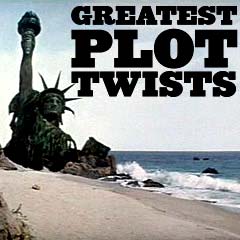
|
|
|
||||||||||||||||||||||||||
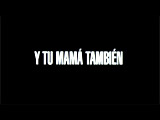
|
Y Tu Mama Tambien (2001, Mex./US) (aka And Your Mother Too)
This unrated tale of sexual discovery from director Alfonso Cuaron had a lengthy tagline when translated:
Set in the late 1990s, it told about two sexually-active, hormone-challenged, 17 year-old Mexican boys, who had both hetero and homosexual camaraderie with each other:
Both males had sex with their girlfriends before they left for the summer, to travel in Italy. There were avowed promises made over being faithful between the couples. They also experienced co-mutual masturbation while both were lying on parallel diving boards at a local public swimming pool. Then, the two over-sexed boys met an intriguing woman about 10 years older than themselves at a wedding:
They decided to take a short road trip, with Luisa as a traveling companion, to find a make-believe, idyllic beach named Heaven's Mouth (Boca Del Cielo). As their sexual and life tutor, she taught the two vulgar lads lessons about life, enticed and had sex with both of them - separately (first Tenoch, then Julio) and eventually together, although they expressed jealous sexual rivalry and boyish machismo over her. Luisa attempted to tell the competitive boys that she preferred neither of her companions romantically over the other. There were other tensions based upon the socio-economic differences between the two teens -- they called each other "hillbilly" and "yuppie" respectively. And it was later revealed that both teens had clandestinely slept with each other's girlfriend many times. And shockingly, Julio also confessed that he had sex with Tenoch’s mother -- the basis for the film's title: "And your mother, too" - but was it said in jest or not? In the film's most famous and pivotal scene, Luisa danced with both boys (one on either side) in a cantina to the sound of a jukebox, then gradually led them to their hotel bedroom for a threesome. She provided the catalyst for them to experience something entirely different between themselves. As they eagerly stripped her down and kissed her, she coaxed the teens to be drawn to each other and kiss (and embrace), while she ducked down and pleasured each of them simultaneously with her hand. The next morning, they woke up sleeping naked next to each other. Ultimately, this homosexual encounter severed the bond between the two males.
After a journey of self- and sexual discovery with Luisa (who often displayed intermittent tears), the two left her at the beach with a fisherman's family that had lived there for four generations. Their journey ended at the isolated beach where she decided to have an end-of-life experience, due to a terminal illness. She said her last words to them (delivered by the narrator Daniel Giménez Cacho), as she dove into the ocean:
One year later, the two met for coffee and during their conversation, Tenoch revealed that Luisa had been terminally ill with cancer during their trip. Although she had visited the doctor about some tests, it wasn't known until the final minutes that she left her unfaithful husband for an end-of-life experience, and had died about a month after their trip. |
 Julio With Girlfriend Cecilia (Maria Aura)  Tenoch With Girlfriend Ana(Ana López Mercado)  Luisa Having Sex with Tenoch  Luisa Having Sex With Julio in Back Seat of Car   On the Beach   Dancing With Both Boys  The Next Morning 
|
||||||||||||||||||||||||

|
Young Sherlock Holmes (1985)
This mystery/adventure film from director Barry Levinson (and executive-produced by Steven Spielberg, with similarities to his Indiana Jones and the Temple of Doom (1984)) had two taglines:
It was a speculative reimagining of the backstory of the famed Sir Arthur Conan Doyle character from the Victorian Era. After the opening credits, the prologue stated:
The drama was mostly noted for its revolutionary visual effects. It was the first feature film to have a completely CGI (computer graphics image) character - a knight that emerged alive from a stained-glass window. Before the credits, the film started with the appearance of a mysterious figure with a dark hood. Armed with a blowpipe loaded with thorns (dipped in a hallucinogenic substance), he shot a prominent and wealthy Britisher named Mr. Bentley Bobster (Patrick Newell) in the neck - and shortly later in a fancy restaurant, the victim suffered "nightmare-like hallucinations" while eating his favorite dinner. The bird on his plate came alive and attacked him. Embarrassed, he fled from the startled patrons in the restaurant to his home, where he suffered a disorienting delusionary death when objects in his bedroom came alive, attacked, and imaginary flames threatened to consume him. He suicidally hurled himself through his upstairs window and died on the cobblestone street below. The ominous shadowy figure of his assassin walked by his corpse. The title character was soon introduced, exemplifying his brilliant ability to deduce numerous facts from simple observation:
His sidekick was bespectacled, slightly chubby fellow student John Watson (Alan Cox), and both were enrolled at an English boarding school, the Brompton Academy in London. Holmes advised Watson: "The deductive mind never rests, Watson. It's rather like a finely-tuned musical instrument. It demands attention and practice." There were two more strange deaths of school staff members:
Deep within a London warehouse, Holmes, Watson, and Holmes' love interest Elizabeth Hardy (Sophie Ward) (Waxflatter's niece) discovered a massive, underground wooden pyramid temple. They witnessed a secret ceremony (a live human sacrifice of a young girl wrapped like a mummy) conducted by an ancient, clandestine Egyptian cult known as Rame Tep that worshipped Osiris. The symbol of Rame Tap was two golden serpents.
When Holmes interrupted the sacrifice, the trio were chased to the London Cemetery, where they were all shot with a blowpipe thorn and suffered frightening hallucinations, although they escaped and survived. Through further investigations and sleuthing, Holmes learned more about the history of the evil Egyptian cult from the school's Chester Cragwitch (Freddie Jones), before he became the fourth victim (after Bobster, Nesbitt, and Waxflatter). Many years earlier, Cragwitch was one member of a group of six British businessmen who made plans to build a luxury hotel in Egypt ("a land of opportunity"). During excavations, they made a "major archaeological find" - an underground pyramid (and temple to Rame Tap), holding the ancient tombs of five Egyptian princesses. All the relics and treasures were sent to England. However, local villagers felt that their "sacred ground" had been desecrated, and there was an uprising. A number of local villagers were killed when the British Army quelled the riot. A young local boy of Anglo-Egyptian descent named Eh-Tar fled to London with his sister, while back in Egypt, their parents were killed in their village when the British sent in troops to keep the peace. The orphaned Eh-Tar vowed revenge on the British builders who had desecrated the temple - and also sought to replace the bodies of the stolen five Egyptian princesses: ("The boy vowed when he grew to manhood that the Rame Tep would take their revenge and replace the bodies of the five Egyptian princesses"). [Later, it was revealed that the school nurse Mrs. Dribb (Susan Fleetwood) was Eh-Tar's younger sister.] Holmes and Watson deduced the identity of the villainous and vengeful Eh-tar, engaged in human sacrifice: it was Professor Rathe (Anthony Higgins), Holmes' own fencing teacher and eccentric schoolmaster. The two young sleuths attempted to rescue Elizabeth (who was being prepared in the temple as the 5th and final sacrificial victim) after Rathe had abducted her. Holmes created a diversion by crashing a massive light fixture onto the worshippers, and the two fought off attacks amidst fires that had broken out; Elizabeth was released by Watson, but then recaptured by Rathe; the two sleuths were able to pursue Rathe to a dock area where they retrieved Elizabeth from being abducted, but Rathe pulled out a pistol; Elizabeth was shot and lethally wounded when she stepped into the line of Rathe's gunfire and saved Holmes. While Watson attended to Elizabeth, Holmes fought to-the-death in a sword duel with Rathe on the dock, who appeared to die when he tumbled through the surface of an iced-over Thames River. When Holmes returned to Elizabeth in a poignant scene, she engaged in a dying exchange with him, with a sad farewell: (Elizabeth: "Don't be sad." Sherlock: "Someday, we'll be reunited, another world, a much better world." Elizabeth: "I'll be waiting. And you'll be late, as always"). After she passed away in his arms, Sherlock nuzzled her close to him as a teardrop ran down the bridge of his nose and he cried out: ("Elizabeth, no... No!") -- marking, according to young John Watson, the last time Holmes ever shed a tear. Later after the mystery was solved, Watson happened to make an off-hand comment to Holmes about Rathe and one "important clue" that he had not known - Rathe's name was Eh-tar spelled backwards. Holmes would declare he was transferring from the Academy: ("There are too many memories here"). When Watson protested: ("Holmes, you have your entire life ahead of you!"), he calmly replied: ("Then I'll spend it alone"). One had to wait for a surprise twist following the end credits. Ehtar/Rathe was revealed to still be alive. He signed his name in an Alpine Inn guestbook as "Moriarty", as the camera captured his devilish raised right eyebrow.
He would live on to become Holmes' future literary arch-nemesis and arch-enemy. |
 The Black-Hooded Blowpipe Assassin   Attacks on Victim Mr. Bobster at Restaurant and in His Home  The Death of Mr. Bobster on the Cobblestone  Young Sherlock Holmes (Nicholas Rowe)  John Watson (Alan Cox)  Lethal Attack by Stained-Glass Knight on Rev. Nesbitt  Dying Professor Waxflatter's Clue: "Eh-tar"  Professor Rathe (Anthony Higgins): The Egyptian Osiris Cult Leader - Eh-Tar  Abducted Elizabeth Hardy (Sophie Ward) Prepared as the Final Human Sacrifice  Rathe Firing At the Group 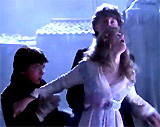 Elizabeth Shielding Holmes - Shot in the Abdomen  Rathe's 'Death' - Falling Through Ice   Elizabeth's Farewell and Death |
||||||||||||||||||||||||

|
Zabriskie Point (1970)
Italian director Michelangelo Antonioni's simplistic and failed view of 1960s America was this iconic movie. It was his first (and only) US film, and his second English-language film following Blow-Up (1966, UK). The controversial, anti-Establishment and counter-cultural film, with two disconnected and disillusioned young people as its stars, came out the same year as the Woodstock Festival. It also was released a year after director/star Dennis Hopper's similar culture-clash film Easy Rider (1969). It was an embarrassing financial box-office disaster for MGM, due to its low revenue of approx. $1 million, on a budget of $7 million. The tagline of this unique, one-of-a-kind film was: "Zabriskie Point - How you get there depends on where you're at." There were basically only two main characters:
Toward its conclusion, she met up with Mark and drove off with him into the desolate desert and into an area of open landscape known as "no-man's land" of Death Valley; in a parking lot overlook at Zabriskie Point - the lowest point in the United States, she read the display sign before they ran down the very steep slope to the dry river-bed where Daria smoked marijuana, while he abstained. As the uninhibited couple walked on, now holding hands, she decided to pretend that their thoughts were like plants, and asked: "What do you see? Neat rows? Like a garden? Or wild things? Like ferns and weeds and vines?"; he replied: "I see, sort of, a jungle"; she thought about how nice it would be if the thoughts planted in their heads didn't include "bad memories...wonderful things, like a happy childhood, real groovy parents, only good things"; he thought her idea was "far out" - and proposed: "Make out and forget how terrible it really was"; after frolicking around in the dust and shouting to produce echos, she offered another unusual thought: "Anyway ought to be one word. The name of some place or a river. The So-Anyway River"; shortly later, he asked her to join him on his life's journey: "Would you like to go with me...wherever I'm going?" They began to kiss, undress each other, and make love on the desert sand dunes, to the tune of the Grateful Dead's Jerry Garcia playing "Love Scene" on the soundtrack; it was the film's most extraordinary sequence - an hallucinatory, symbolic, dust-swirling orgy or love-making sequence; several dozen ash-covered copulating and kissing couples (and trios) (at least 100 phantom individuals, credited as the improv Open Theatre group of Joe Chaikin) magically appeared, creating a massive 'love-in'; the views of the contorting bodies began to blend into the landscape, uniting and becoming one.
After the free-love experience and the dust cleared, Mark remarked: "I always knew it'd be like this"; Daria asked: "Us?" but he replied instead: "The desert." Knowing that he was wanted by the police, Mark was anxious to return to Los Angeles by flying back and surrendering the hijacked plane - now decorated with additional flowers, slogans, and peace/love symbols: (NO WORDS, SUCK BUCKS, FREECOME, SHE HE IT - or a long drawn-out "SHEE-IT"). At the Hawthorne airport after he landed - on his death-defying return trip, Mark's plane was greeted and surrounded by awaiting police patrol cars and KRLA media reporters; as he was chased down the runway (and was believed to be evading capture), he turned the plane onto the grass where he was brutally shot dead in the cockpit by indiscriminating gunfire (Mark was briefly glimpsed slumped over onto the controls). Daria continued to drive onward to Phoenix, and arrived at attorney Mr. Allen's luxurious, ultra-modern, maze-like desert dwelling built amongst huge boulders; her boss was conducting a business meeting there about his real-estate plans. She became distressed by the wealth, greed and empty opulence of the place and Mr. Allen's affluent cohorts, and with an appalled reaction to everything, she decided she didn't want to remain there, and ran to her car in the parking area. As she drove away from the home, she stopped the car, softly caressed the red shirt Mark had given her, and turned around; in the film's explosion-filled finale accompanied by a Pink Floyd soundtrack, she appeared to have an angry, anarchic wish-fulfillment hallucination, fantasy or dream - symbolizing the destruction of capitalistic excess; it was similar to Mark's revolutionary impulses, and to the previous orgasmic sequence in the desert.
The structure was blown up in slow-motion (seen repeatedly exploding from almost a dozen different angles, using 17 camera set-ups); in addition, various materialistic consumer items were seen being destroyed in slow-motion and in extreme close-up (pool furniture, racks of designer clothes, a refrigerator with a cascading and disintegrating loaf of packaged WONDER bread, flying frozen chickens, a box of Special K, a banana, a TV set, and shelves of books); she observed or imagined the apocalyptic end of the materialistic and capitalistic America. The film ended with Daria beaming as she looked up at the house (had it really been destroyed, or was it only in her mind?); the film ended as she drove away into the desert and an uncertain future (to the tune of Roy Orbison's "So Young"), as the camera panned over to view the golden rays of the sun as it set. |
 Dropout/Drifter Mark (Mark Frechette) 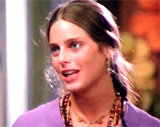 Hippyish Daria (Daria Halprin) - Temp Office Worker-Secretary 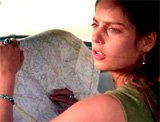 Daria - Enroute in a Car to Phoenix, AZ  Real-Estate Developer Mr. Allen (Rod Taylor) 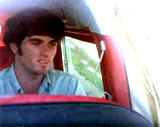 Mark in Hijacked Cessna Airplane Heading Toward Phoenix  Daria in Buick Also Headed Eastward  Together At the River-Bed Below the Overlook at Zabriskie Point in Death Valley 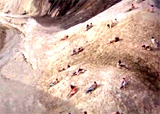 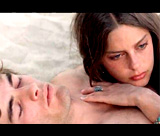 The End Shot of the "Love-In" in the Desert  Mark's Landed Plane Surrounded by Police Cars And Fired at Indiscriminately 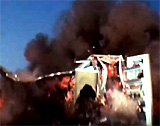 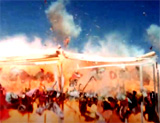 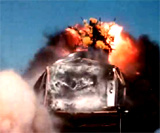 Consumer Items Blown Up - a Refrigerator, a Rack of Clothes, a Television |
||||||||||||||||||||||||
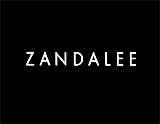
|
Zandalee (1991)
This erotic, steamy bayou thriller and romantic tragedy by director Sam Pillsbury told about a love triangle in New Orleans between:
Bored and frustrated by her life and impotent marriage, the vixenish wife turned to the selfishly-hedonistic, predatory Johnny for uninhibited and passionate sexual encounters. Their self-destructive affair led to Johnny's request that she leave her husband, although she refused and recommitted herself to her marriage. Obsessed by Zandalee, drugged-up Johnny pursued the married couple to the bayou where they went to patch up their relationship, "start clean," wear flowers in their hair, and make love after many months ("See, all our parts work"). A tragic end came to all of them - the cuckolded husband committed suicide in the bayou when he plunged into the water from the speeding boat driven by Johnny - he drowned when he wouldn't allow himself to be saved ("He wanted to be let go"). Back in New Orleans after her husband's burial, Johnny confessed to Zandalee his longing for her: "I can't get you out of me" - but she slapped him: "You don't know anything about love." And then Zandalee sacrificially jumped in front of a bullet intended for indebted Johnny, in a drive-by shooting by a drug lord who yelled out: "You gotta make accounts payable, man." She died in his arms on the street, after which he carried her limp body to the nearby cathedral. |
 Johnny With Zandalee (Erika Anderson)  The Love Triangle  The Drowning of Johnny  The Death of Zandalee in Johnny's Arms |
||||||||||||||||||||||||